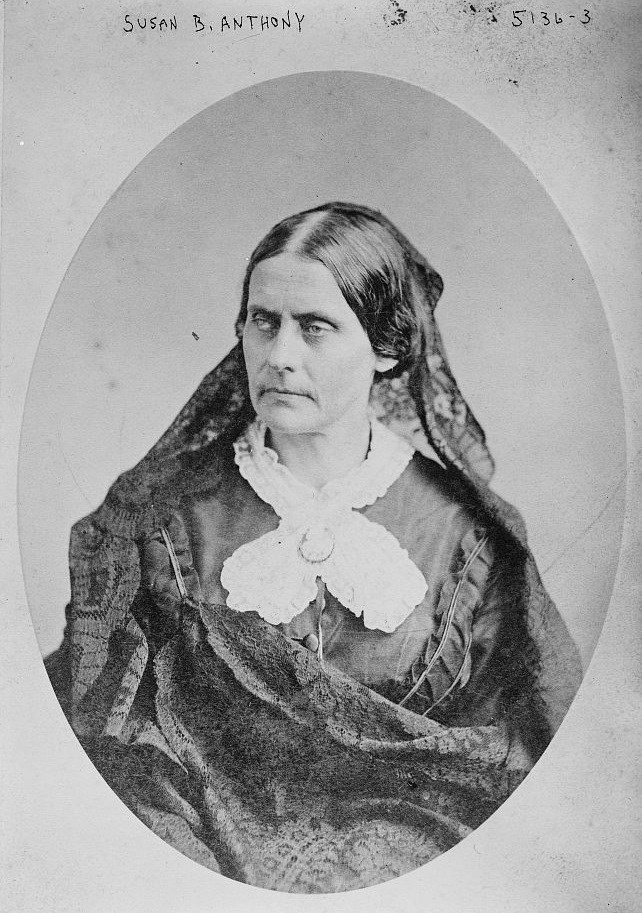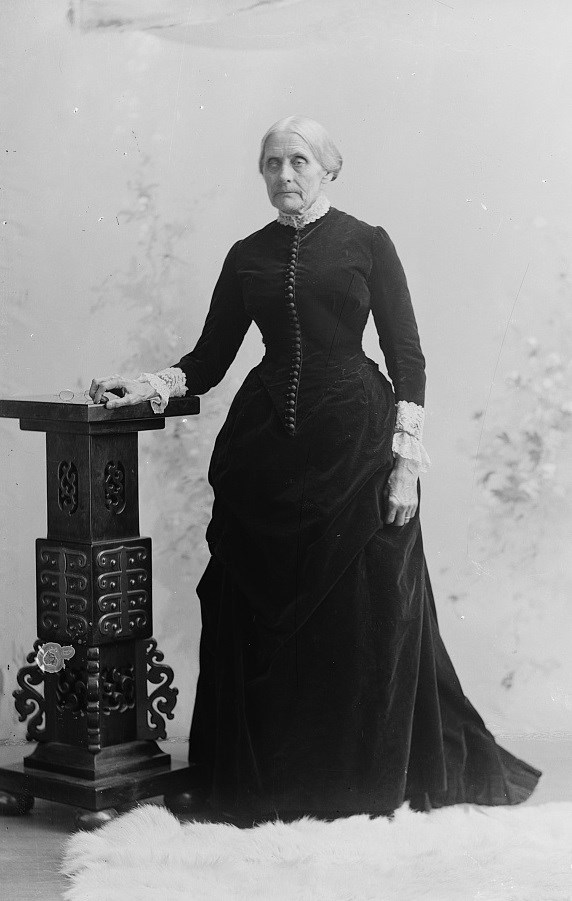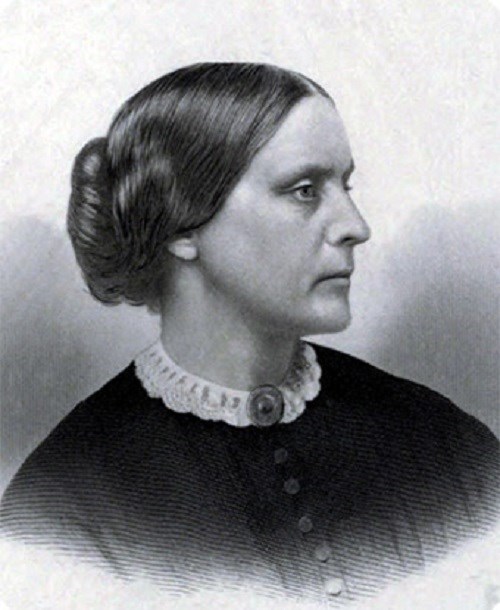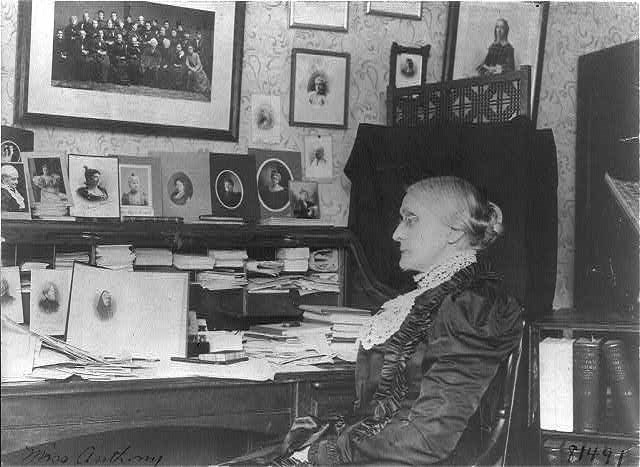Part of a series of articles titled Curiosity Kit: Susan B. Anthony .
Article
Learning From Susan B. Anthony

These activities were researched and written by Alison Russell a NCPE intern with the Cultural Resources Office of Interpretation and Education.
Susan B. Anthony is one of the most recognizable suffragists. She was born in Adams, Massachusetts in 1820. Her family moved to Rochester, New York in 1845 where she lived and worked for most of her life. Her family participated in the anti-slavery and early women’s rights movements. Their work introduced Anthony to activism as a young woman. She met Lucy Stone and Elizabeth Cady Stanton in the 1850s. In 1868, Anthony and Stanton founded the American Equal Rights Association and edited The Revolution, a women’s rights newspaper.
The debate over the Fifteenth Amendment, which granted voting rights to African American men but not women, caused Anthony and Stanton to split from other suffragists and allies, basing their objections on racist assumptions. They formed the National Women Suffrage Association to focus on women’s right to vote. Anthony and her sisters voted in the 1872 and were arrested. In the 1880s, Anthony, Stanton, and Matilda Josyln Gage wrote “The History of Woman Suffrage.” While it detailed white women’s contributions, women of color’s efforts were not included.
Anthony traveled and fought tirelessly for women’s right to vote. She was an accomplished speaker and organizer. Susan B. Anthony died in 1906 in her home in Rochester. The Nineteenth Amendment, named the Susan B. Anthony Amendment in her honor, was ratified in 1920. You can find out more about Anthony by visiting this article about her and by exploring the Places of Susan B. Anthony.
Objectives
-
Identify rights and privileges protected for all citizens of the United States and evaluate voting as a privilege.
-
Connect the actions of a historical figure to the ways we see and remember them.
-
Create images and memorials using different symbols, composition, or action based on the message you are trying to convey.
Inquiry Question
What is a cause worth dedicating your life to? Is there a cause that is more important than all the others?

Activity 1: What are the Rights in Equal Rights?
Susan B. Anthony was arrested for trying to vote in 1872. In court, she argued the Fourteenth Amendment guaranteed rights to all citizens. Therefore, as a natural-born citizen, she was within her rights to vote. The Fourteenth Amendment says that “All persons born or naturalized in the United States and subject to the jurisdiction thereof, are citizens of the United States.” It continues, “No state shall make or enforce any law which shall abridge the privileges or immunities of citizens.”
What does the Fourteenth Amendment guarantee? Make a list of what “privileges” you think are guaranteed to citizens of the United States. Where does voting fit? Do you agree with Anthony’s characterization in this 1872 speech:
“Is the right to vote one of the privileges or immunities of citizens? I think the disfranchised ex-rebels, and the ex-state prisoners will agree with me, that it is not only one of them, but the one without which all others are nothing. Seek the first kingdom of the ballot, and all things else shall be given thee, is the political injunction…. To be a person was to be a citizen, and to be a citizen was to be a voter.”1
Since Anthony’s argument, the Supreme Court has listed some but not all privileges protected by the Fourteenth Amendment. These include access to the seats of government and courts, access to seaports, protection abroad, the right of assembly, to access public lands, to pass from state to state, and to vote for national officers, among others. Is it a good idea to have a list of what counts as a privilege? Are there any disadvantages to listing them? Are there any that you would add to the list?
Voting is still not guaranteed to all citizens. The Fifteenth, Nineteenth, Twenty- Third and Twenty- Sixth Amendments have helped expand voting, but as of 2020 only 66% of eligible Americans are registered to vote.2 Other Americans aren’t even eligible because of age, geographic location or former incarcerated status. How do you think Anthony would view this access to the ballot? How do you? Do you think their should be restrictions or limitations on access to voting? Do you think more people should be able to vote? Why?
To learn more about the interpretation of the Privileges and Immunities Clause Check out these essays from the National Constitution Center.
Activity 2: Symbols of Memory
Ratified fourteen years after her death, the Nineteenth Amendment extended the right to vote to women. Lawmakers and activists called it the Susan B. Anthony Amendment in her honor. In recent years, voters have left “I Voted” stickers on Anthony’s grave as a tribute. Anthony was also the first woman to appear on U.S. currency. Her portrait appeared on the dollar coin from 1971 to 1981 and in 1999.
Commemorating a historical figure doesn’t just have to come in the form of a statue, or even an official action. What’s important is to make a connection with that historical figure and why they are important you. Think about a person who fought for progress you benefit from directly or indirectly. What’s one thing you can do to show you appreciate the work of a person in history? Is there an action you can take? Is there an art form (painting, song, poem) that you could dedicate to them? Is there a group or organization that does work that honors the person you are celebrating? Can you volunteer or do something to support your shared mission?
Activity 3: A Picture’s worth a thousand words
Susan B. Anthony co-wrote a history of women’s suffrage, focused on the efforts of white women. She oversaw the images for the book. She wanted the portraits of women to counter the negative stereotypes of suffragists in popular media. Borrowing strategies from anti-slavery reformers, Anthony wrote and gave specific instructions on pose, dress and setting to featured women. It is Anthony herself who has become one of the most recognizable suffragists. Look at her picture in “The History of Woman Suffrage.” What message do you think she is trying to send with her pose, facial expression and dress? Forty-five years after the image and twenty years after the publication of the book, Anthony sat for a new portrait. How is this one different? What parts of the picture stand out to you? What message do you think this is trying to convey to the viewer?

Susan B. Anthony, c. 1855.
From "The History of Woman Suffrage" by Anthony and Elizabeth Cady Stanton, Volume 1, 1881.

Susan B. Anthony seated at her desk, 1900. Collections of the Library of Congress (https://www.loc.gov/pictures/item/2016651849/).
Think about how different pictures of the same person can say or do different things. Take photos with your friends or family members. Try to convey serious, funny, inspiring, and other emotions. How do you change the person’s pose, the framing of the photograph or even what accessories they use to create the mood? What does the picture tell a viewer about that person? What does it hide?
Last updated: August 9, 2021
